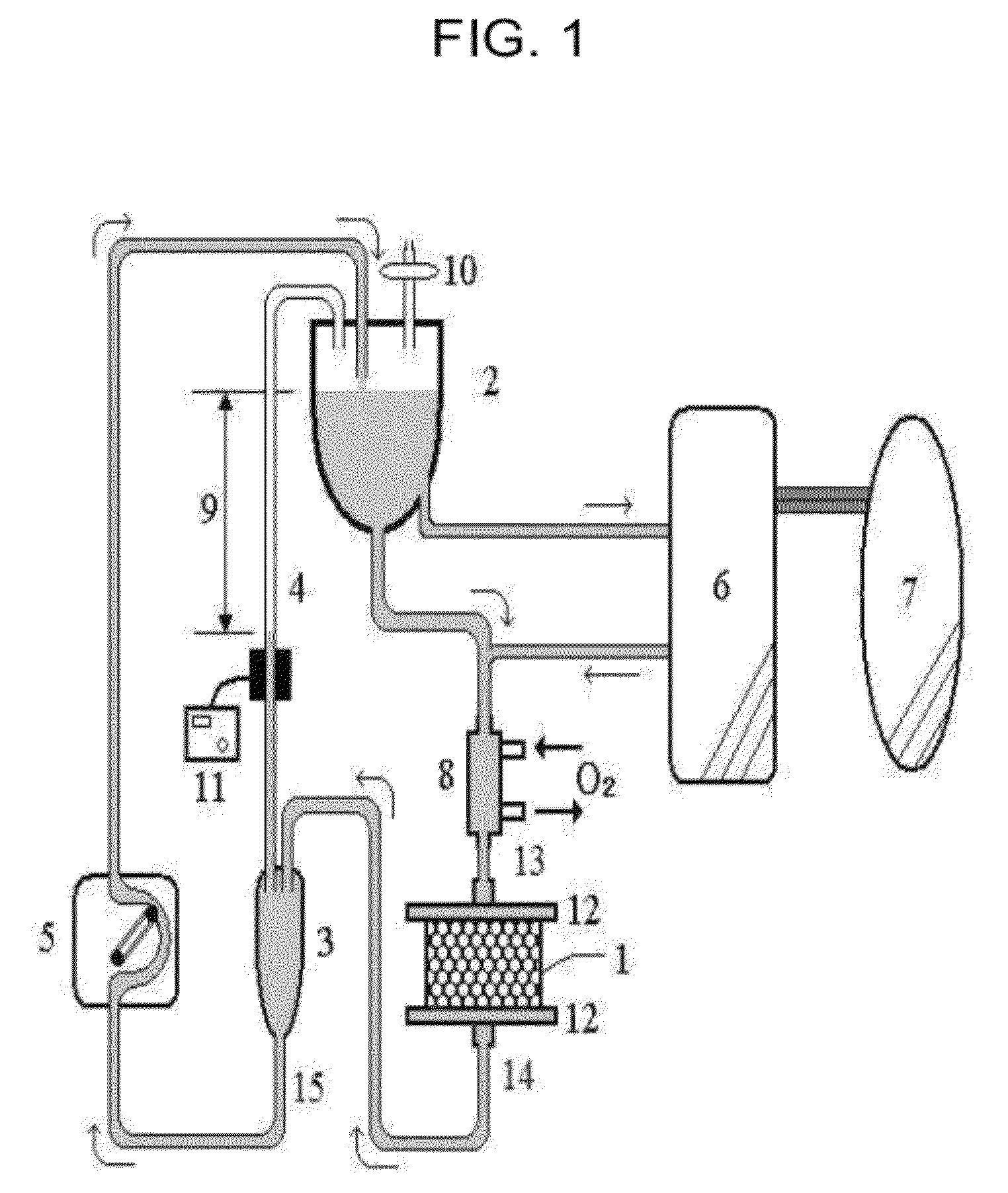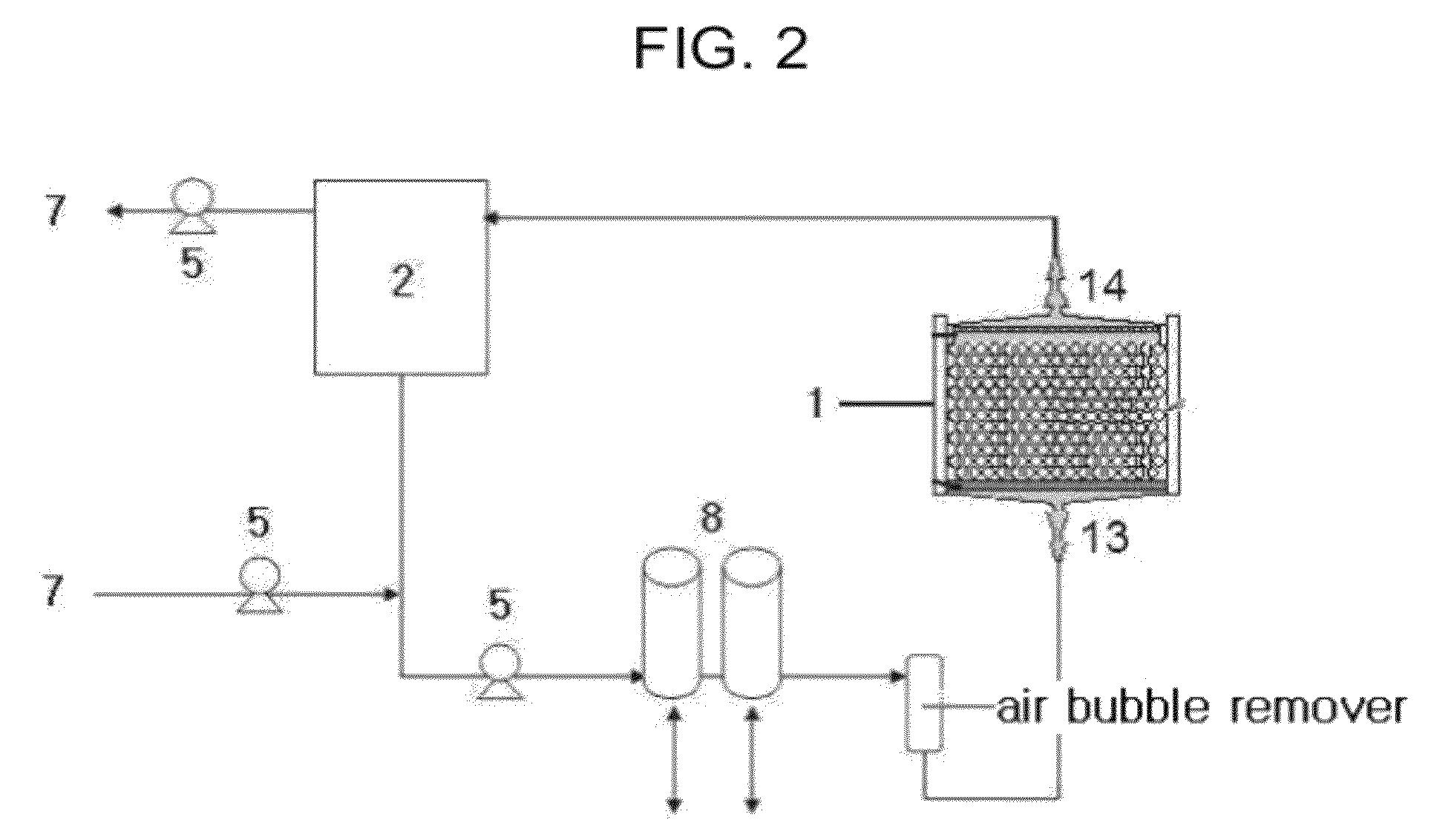Bioartificial liver system using bioreactor packed with gel beads
a bioreactor and gel technology, applied in the field of bioartificial liver systems using bioreactors, can solve the problems of limiting the throughput capacity of the reactor, unable to replace liver functions, and necrosis of hepatocytes
- Summary
- Abstract
- Description
- Claims
- Application Information
AI Technical Summary
Benefits of technology
Problems solved by technology
Method used
Image
Examples
experimental example 1
In Vitro Performance Test of the Inventive Bioartificial Liver System
[0048]In order to simulate the treatment of an actual hepatic failure patient, the bioartificial liver system of the present invention was supplied with a suspension culture medium (Williams' E medium containing insulin 5 mg / l, albumin 0.1% and epithelial cell growth factor 20 μg / ml, Sigma Chemical Company) containing 1300 μg / dl ammonia (exaggerated condition) for the initial 7 hours, and, subsequently, with a suspension culture medium containing 420 μg / dl ammonia (the level observed in an actual hepatic failure case) for 4 hours, wherein the feed rate of each medium was set at 6 ml / min.
[0049]The results in FIG. 4 show that after such treatment, about 77% of ammonia was removed from the medium, and such a high detoxifying capacity remained unchanged even after 11 hours.
experimental example 2
Performance Test for the Liver-Assisting Function Using a Hepatic Failure Pig
[0050]A shoat weighing about 50 kg (available as an international experimental animal, 3 to 4 months old) was systemically anesthetized and subjected to endotracheal intubation, followed by securing blood vessel for collecting blood sample. Anesthesia was maintained by subjecting the animal to inhalation of enflurane (Choongwae Pharma Corporation).
[0051]After cutting open the abdomen of the anesthetized shoat, the infrahepatic inferior vena cava and portal vein were connected in the way of side-to-side anastomosis to bypass the blood stream to the jugular vein, thereby inducing hepatic failure.
[0052]A double lumen catheter was inserted into the jugular vein of the hepatic failure-induced shoat and connected to the plasma separator (6, Cobe Spectra, Gambro BCT, USA) of the inventive bioartificial liver system.
[0053]Operating conditions were as follows:
[0054]Blood circulating rate within the plasma separator:...
experimental example 3
Comparison of Gel Bead Damage Between the Inventive Bioartificial Liver System and a Conventional One
[0060]In order to verify the superior stability of the inventive bioartificial liver system, a bioartificial liver system was manufactured in the same way as described in the above Example, except that the volume of a bioreactor 1 was changed to 260 ml.
[0061]Meanwhile, a comparative system as illustrated in FIG. 2 was manufactured in accordance with the conventional method (see Korean Patent Laid-open Publication No. 2006-48546) by: packing hepatocytes-containing gel beads which had been manufactured as described in steps 1) and 2) of the above Example in a bioreactor having a volume of 260 ml; adjusting the upper plate of the bioreactor to compress the upper level of the naturally precipitated gel beads by 20%; and circulating the plasma from the bottom to the top of the bioreactor by using a tube pump.
[0062]A test solution was obtained by mixing the porcine plasma recovered from th...
PUM
| Property | Measurement | Unit |
|---|---|---|
| vertical height | aaaaa | aaaaa |
| pressure | aaaaa | aaaaa |
| pore size | aaaaa | aaaaa |
Abstract
Description
Claims
Application Information
 Login to View More
Login to View More - R&D
- Intellectual Property
- Life Sciences
- Materials
- Tech Scout
- Unparalleled Data Quality
- Higher Quality Content
- 60% Fewer Hallucinations
Browse by: Latest US Patents, China's latest patents, Technical Efficacy Thesaurus, Application Domain, Technology Topic, Popular Technical Reports.
© 2025 PatSnap. All rights reserved.Legal|Privacy policy|Modern Slavery Act Transparency Statement|Sitemap|About US| Contact US: help@patsnap.com



